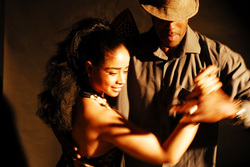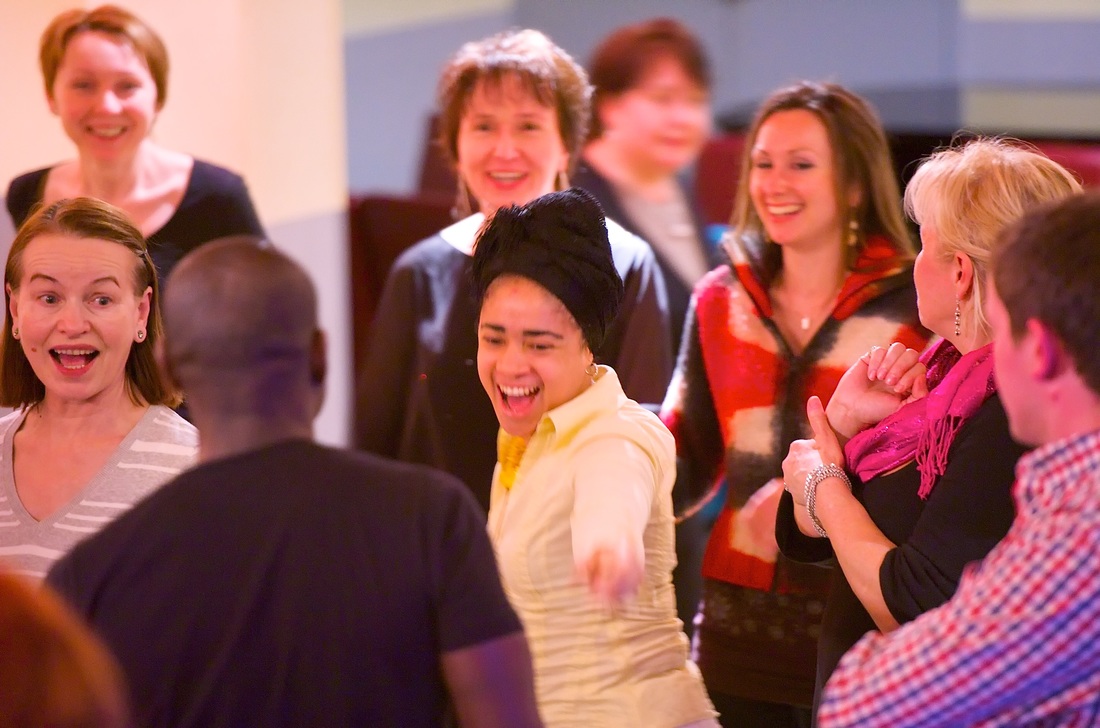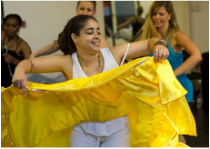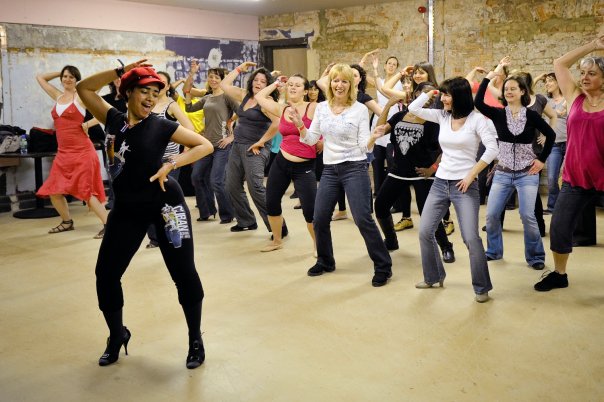Learn to dance or improve your Cuban Rumba
Dancing is one of the best ways to relieve stress and bring happiness to your life. We offer Rumba classes that are full of fun along with great technique.
What you will learnLearn Authentic Cuban moves from basic beginners moves, improvers, intermediate, all the way to advanced level. Focus is placed on teaching the correct Rumba technique, including movement, gesture, props, as well as musicality and concept. How to protect and various ways of interaction and "vacuna"
Why dance with us?Get it right from the beginning. We don't only teach moves. Classes are designed to help focus and work on your posture, technique, connection, musicality, dance concept, space awareness and eventually exciting moves to make your dance more versatile, fluid and enjoyable.....
Our teachers are passionate and knowledgeable in the material they teach. Plus we follow our own dance syllabus as well as level of class. Classes are done a a comfortable dance studio. |
NEW 3 Weeks INTENSE Rumba course stars 18th April!
|
No dance partner neededCome on your own or join us with a group of friends.
|
All dance levels welcome |
Flexible payment optionsWhether you want to join us for a single class or pay for a few weeks with a discount.
|
Start your Rumba experience with one of these classes
PAYMENT info & OptionsCourse duration: ONLY 3 weeks !
Direct Transfer infoWe operate a ticket-free scheme. Your name will be registered on our list at the door. If you prefer to the a transfer please email us with your name and class name or fill up the booking form at the end of the class you selected page.
Please make transfer to: Name: Cuban School of Arts Branch: HSBC Sort code: 40-02-17 Account: # 21570412 REFERENCE & PRICE GUIDE Via Transfer 3 weeks - £45 - RUM3 (plus your name) Drop In* - £17 - RUM ( plus date & your name) DON’T MISS OUT! Sign up now! DON’T MISS OUT! Sign up now! *Payment are not refundable neither transferable. **There are limited spaces available on this course. ***Drop in payment needs to be transfer minimum of 2 days in advance |
Online PaymentNEW COURSE starts 18th April 2018
Unleash the dancer within!! Get the basics right and spice up your dance movements!! Focus of the course Rumba history, timing, styling Clave understanding & Salsa timing (listen to the beat) Partner work ( Following & Leading technique) Close attention to Gestures & Postures Tips – what to do & not to do! Scroll down for course benefits, focus and more *On door payment it is only in cash and can be higher **There are limited spaces available on this course. *** If you are STUDENT in Full Time Education with ID or NUS card click here |
Time & LocationThe Place Dance Studio
16 FLAXMAN TERRACE, London WC1H 9AT Wednesday: 20:00 -21:30 |
TestimonialsGreat classes!! Damarys you are an amazing "Rumbera" and a passionate teacher. I've been looking for a class like this for years. I now understand more about Rumba and feel comfortable protecting from "vacunas" :-) Gracias I really enjoyed introducing more Afro into Rumba. I love all the individual attention we get. I know we always complain when we have to improvise (!), but it is what we need to learn how to do it. Great accessible dance studio with mirrors, which helps lots for the styling. |
What is rumba?
Cuban Rumba
Is a Popular Afro-Cuban dance, which arose in Havana in the 1890s. The rumba complex includes the yambu, the guaguanco and the columbia. As a sexually charged Afro-Cuban dance, rumba was often suppressed and restricted because it was viewed as dangerous and lewd.
A partner dance were the woman and man represent theatrically different occurrences from their everyday lives, interpretations though rudimentary instruments and songs. Opposite to “Yambu” in the “Guaguanco” the rhythm is slightly faster as are the movements. It is characterised by the actions the man carries out towards the woman, known as “Vacunao”, a movement the man carries out towards the pelvis of the woman, which it doesn't occurs in the Yambu. Important styles of the columbia are the jiribilla and the rumba de botella; boxes and tumbadoras are very commonly used as instruments.
Is a Popular Afro-Cuban dance, which arose in Havana in the 1890s. The rumba complex includes the yambu, the guaguanco and the columbia. As a sexually charged Afro-Cuban dance, rumba was often suppressed and restricted because it was viewed as dangerous and lewd.
A partner dance were the woman and man represent theatrically different occurrences from their everyday lives, interpretations though rudimentary instruments and songs. Opposite to “Yambu” in the “Guaguanco” the rhythm is slightly faster as are the movements. It is characterised by the actions the man carries out towards the woman, known as “Vacunao”, a movement the man carries out towards the pelvis of the woman, which it doesn't occurs in the Yambu. Important styles of the columbia are the jiribilla and the rumba de botella; boxes and tumbadoras are very commonly used as instruments.
What is yambu, guaguanco , columbia?
Yambú: Modality of the rumba. It is a dance with much relationship between the dancers, with courting, flirting and soft and cadenced movements. Its rhythm is generally slow, with no strong or abrupt gestures. There is no vacunao, that is, the man makes no erotic movements towards the woman's pelvis. Lyrics are brief and, at times, there is a humming, called diana, marking the entrance of the chorus. It is considered an "old people's rumba".
RUMBA YAMBU : Yambú is the oldest and slowest known style of rumba, sometimes called the Old People’s Rumba. It uses the slowest beat of the three Rumba styles and incorporates movements feigning frailty. It can be danced alone (especially by women) or by men and women together. Although male dancers may flirt with female dancers during the dance, they do not use the vacunao of Rumba Guaguancó.
Guaguancó: Variation of the rumba in urban areas with a prevalence of people of African descent. The totally spontaneous and extemporized movements and communication of the dancing partners should match perfectly. While dancing, the woman, while constantly flirting and provoking the man, is always attentive to prevent the vacunao, an essential element in the dance, from taking place. It is a form of dance where flirting, courting, rejoice and eroticism prevail. The initial lyrics are long and take the form of a long narration, referring to an event or an individual, thus its meaning has to do with a moment or occasion. The melodic line is more fluid than in other rumba modalities. At times it starts with very long sounds, especially when a singer steals the song from another one and lengthens the first syllable of his song as if it were a call. At times singers use décimas instead of simple quatrains, not necessarily octosyllabic, in their lyrics, or include parts in prose.
RUMBA GUAGUANCó : is faster than yambú, with more complex rhythms, and involves overtly flirtatious movements between a man and a woman in the roles of “Rooster” and “Hen”.The woman both entices and “protects herself” from the man, who tries to catch the woman off-guard with a vacunao-tagging her with the flip of a handkerchief or by throwing his arm, leg or pelvis in her direction in an act of symbolic sexual contact. To defend herself, she may cover with her hand, or use her skirt to protect her pelvis and whip the sexual energy away from her body. Guaguancó most likely inherited the idea of the ‘vacunao’ from yuca or macuta dances, which were both brought to Cuba by Bantú ethnic groups
RUMBA COLUMBIA : (not “Colombia”) is a fast and energetic Rumba. Solo, traditionally male, dancers provoke the drummers, especially the player of the smallest drum (Quinto, here also soloist drum), to play complex rhythms that they imitate through their creative and sometimes acrobatic movements. Men may also compete with other men to display their agility, strength, confidence and even sense of humor. All of these aforementioned aspects of Rumba Columbia are derived from a colonial Cuban martial art/dance called El Juego de Maní which is similar in origin and execution to Brazilian Capoeira. Columbia incorporates many movements derived from Congo dances as well as Spanish flamenco, and more recently dancers have incorporated breakdancing and hip hop moves.
“Columbia” which is only danced by men, demonstrates all the virtues of the dancers: agility, capability and skill in carrying out all movements.
Jiribilla: Variation of the columbia, a modality of rumba. It is a dance for male soloists, characterized by quick and free movements and by extemporization. As in the case of columbia, it can include joking and mimics. It is danced with a handkerchief on the neck or in the hand, while the arms move freely
RUMBA YAMBU : Yambú is the oldest and slowest known style of rumba, sometimes called the Old People’s Rumba. It uses the slowest beat of the three Rumba styles and incorporates movements feigning frailty. It can be danced alone (especially by women) or by men and women together. Although male dancers may flirt with female dancers during the dance, they do not use the vacunao of Rumba Guaguancó.
Guaguancó: Variation of the rumba in urban areas with a prevalence of people of African descent. The totally spontaneous and extemporized movements and communication of the dancing partners should match perfectly. While dancing, the woman, while constantly flirting and provoking the man, is always attentive to prevent the vacunao, an essential element in the dance, from taking place. It is a form of dance where flirting, courting, rejoice and eroticism prevail. The initial lyrics are long and take the form of a long narration, referring to an event or an individual, thus its meaning has to do with a moment or occasion. The melodic line is more fluid than in other rumba modalities. At times it starts with very long sounds, especially when a singer steals the song from another one and lengthens the first syllable of his song as if it were a call. At times singers use décimas instead of simple quatrains, not necessarily octosyllabic, in their lyrics, or include parts in prose.
RUMBA GUAGUANCó : is faster than yambú, with more complex rhythms, and involves overtly flirtatious movements between a man and a woman in the roles of “Rooster” and “Hen”.The woman both entices and “protects herself” from the man, who tries to catch the woman off-guard with a vacunao-tagging her with the flip of a handkerchief or by throwing his arm, leg or pelvis in her direction in an act of symbolic sexual contact. To defend herself, she may cover with her hand, or use her skirt to protect her pelvis and whip the sexual energy away from her body. Guaguancó most likely inherited the idea of the ‘vacunao’ from yuca or macuta dances, which were both brought to Cuba by Bantú ethnic groups
RUMBA COLUMBIA : (not “Colombia”) is a fast and energetic Rumba. Solo, traditionally male, dancers provoke the drummers, especially the player of the smallest drum (Quinto, here also soloist drum), to play complex rhythms that they imitate through their creative and sometimes acrobatic movements. Men may also compete with other men to display their agility, strength, confidence and even sense of humor. All of these aforementioned aspects of Rumba Columbia are derived from a colonial Cuban martial art/dance called El Juego de Maní which is similar in origin and execution to Brazilian Capoeira. Columbia incorporates many movements derived from Congo dances as well as Spanish flamenco, and more recently dancers have incorporated breakdancing and hip hop moves.
“Columbia” which is only danced by men, demonstrates all the virtues of the dancers: agility, capability and skill in carrying out all movements.
Jiribilla: Variation of the columbia, a modality of rumba. It is a dance for male soloists, characterized by quick and free movements and by extemporization. As in the case of columbia, it can include joking and mimics. It is danced with a handkerchief on the neck or in the hand, while the arms move freely
rumba music
RUMBA CUBANA: Cuban music, Rumba is a generic term covering a variety of musical rhythms and associated dances. The rumba has its influences in the music brought to Cuba by Africans brought to Cuba as slaves as well as Spanish colonizers. Rhythmically, rumba is based on the five-stroke pattern called clave (rhythm) and the inherent structure it conveys. Rumba developed in the Cuban provinces of Havana and Matanzas in the late 19th century. The rumba is a dance full of vitality, energy and erotic elements and becomes a game between the sexes. Cuban Rumba can be broken down into three types: Yambú (the oldest and slowest style), Columbia, and Guaguancó.
Instruments: Clave, Drums: Salidor, 3-2, Quinto.
Instruments: Clave, Drums: Salidor, 3-2, Quinto.




